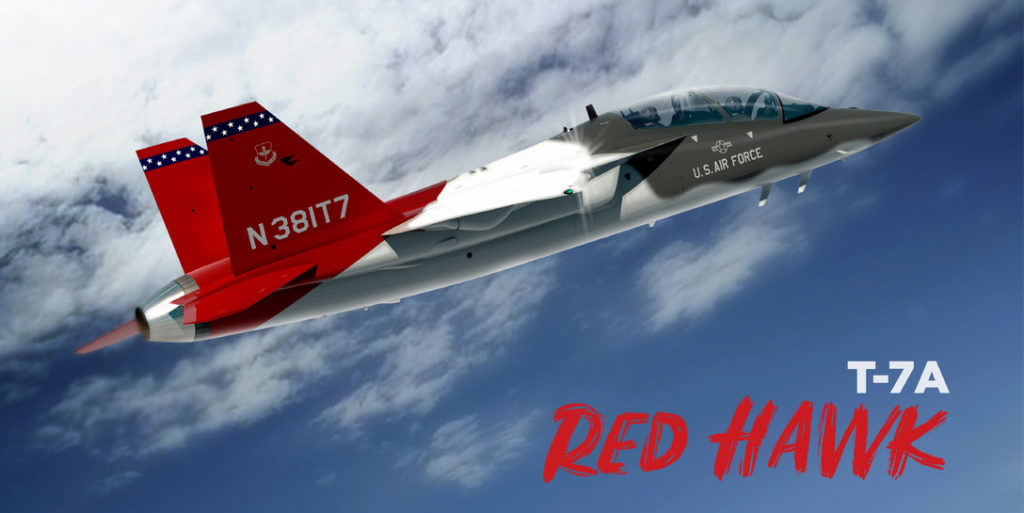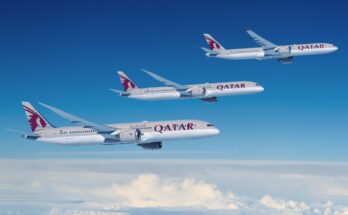
Boeing‘s annus horribilis has culminated in the worst full-year loss in the company’s 103-year history. Nearly the whole year has been consumed by the two fatal crashes of its 737 MAX, the aircraft’s subsequent grounding, and the company’s elusiveness in completing recertification.
For over a year now, the flagship aircraft’s deliveries have been suspended and in-service fleets grounded as Boeing develops a fix for the 737 MAX’s Maneuvering Characteristics Augmentation System. Both crashes have been traced to the MCAS, which suddenly activated in response to erroneous angle of attack information.
With the start of the new year, production of the aircraft has been suspended, and Boeing has prepared itself to take a hit of $18 billion in costs associated in customer concessions and shut down impacts. Funds from this charge will be distributed over several years as the company executes settlements to compensate airline customers.
Early in the crisis, production of the aircraft was slowed from the then-current 52 per month to 42 per month. However, with an inventory of over 400 aircraft sitting on the lot, the company decided to halt production until the plane is back in service. While no timetable has been set, company officials believe the aircraft will return to service by mid-2020.
This shutdown has rippled through Boeing’s aerospace suppliers, most notably former Boeing operation Spirit AeroSystems. While Boeing is working to move 737 workers to other jobs during the shutdown, Spirit has no such luxury and announced layoffs of some 2,800. Other suppliers have followed suit – so much so that, according to various economists as cited in the Wall Street Journal, the shutdown will likely reduce U.S. gross domestic product in the first half of 2020.
The unprecedented scale of the crisis has rattled the aerospace giant. It seemed unable to find stability as the months dragged on and the 737’s return was continually delayed. The firm’s reputation was further sullied as ugly internal messages emerged, impinging the company’s safety and engineering culture. Boeing’s board finally had enough. In December, the board replaced CEO Dennis A. Muilenburg with industry veteran and Boeing board member David L. Calhoun.
“We recognize we have a lot of work to do,” Calhoun said. “We are focused on returning the 737 MAX to service safely and restoring the long-standing trust that the Boeing brand represents with the flying public.”
In a letter to employees, Calhoun laid out his priorities for the year ahead: return the 737 MAX to service safely, rebuild trust, focus on values, operate with excellence, maintain production health, and invest in the future. It’s a big slate, but with the worst hopefully now behind the company, it should be achievable. Calhoun has served in various senior leadership roles within several large-scale enterprises, including at the Blackstone Group, Nielsen Holdings, and GE. During his 26-year tenure at GE, he led multiple business units, including GE Transportation and GE Aircraft Engines. His successful record has shown he is more than capable of following through on ambitious strategies.
In the meantime, 737 MAX test flights and software changes continue. By year-end, Boeing had carried out more than 900 test flights with new MCAS software, for a total of 1,700 flight hours. The U.S. Federal Aviation Administration said it remains focused on following a thorough process for returning the 737 MAX to service. The FAA continues to work with other international aviation safety regulators to review the proposed changes to the aircraft – making it very clear that its first priority is safety and that as such, no timeframe will be set. Overall, the issues are narrowing, and a certification flight is anticipated soon.
That said, the current consensus is that the MAX will return to service in mid-2020. Once this occurs, Boeing will begin the process of slowly restarting production. According to corporate officials, production will not reach the goal of 57 units per month for at least a couple of years. The aforementioned ripples through the company’s supply chain could see this drag out a bit longer, as it may be harder for smaller contractors to reform workforces and meet demands.
At year-end 2019, Boeing’s backlog was 5,625 aircraft – roughly seven-plus years of work at current production rates. The fuel-efficient 737 MAX narrowbody accounts for the majority of the company’s order book with 4,545 on order, despite some cancellations following the grounding of the type.
Boeing/Embraer Tie Up In Home Strech
Boeing and Embraer continue to move forward with their commercial aircraft tie-up, with the merger expected to close shortly once the European Union completes its delayed review. The delays with the EU were attributed to documentation requests rather than anti-competitive concerns.
Under the multilevel deal, the new Boeing Brasil – Commercial (BBC) joint venture will be majority owned by Boeing. Boeing is offering $4.2 billion for an 80 percent stake in BBC. A second venture, Boeing Embraer – Defense, majority owned by Embraer, will focus on promoting and developing the C-390/KC-390 airlifter/refueler. Finally, Embraer will continue to hold on to its business jet operations, which are currently focused on producing the Legacy and Praetor families of executive aircraft.
The formation of BBC was in direct response to the formation of a rival joint venture, majority led by Airbus, to take over the Bombardier CSeries program. This effort, begun in late 2017, became official in July 2018 when Airbus assumed a 50.01 percent controlling stake in the program. The CSeries was quickly rebranded by Airbus as the Airbus A220. In February 2020, Airbus upped its stake to 75 percent as Bombardier exited commercial aircraft production.
Boeing, through BBC, will use its marketing and support operations to push the E-Jets family against the rebranded Airbus A220 lineup. There is very little competitive overlap between Boeing’s and Embraer’s product lines, consisting only of some indirect competition between the E195-E2 and the 737 MAX 7. More importantly, the tie-up will enable a comprehensive and broad-based attack on the Airbus A220 series, with the E190-E2 and E195-E2 challenging the A220-100 version, and the 737 MAX 7 and 737 MAX 8 battling the A220-300.
Boeing-Embraer Defense’s focus will be on the recently rebranded C-390 Millennium military transport and the KC-390 aerial refueling variant. Here, Boeing gains a model to compete against Lockheed Martin’s C-130 military transport.
Defense Remains Stable
Boeing’s defense operations have taken center stage of late, winning several major competitions. In 2018, the company won contracts for the Air Force’s Huey Replacement Program with the MH-139, the U.S. derivative of the Leonardo AW139; the Navy’s carrier-based MQ-25 Stingray unmanned tanker aircraft; and its biggest prize, the Air Force’s T-X trainer competition in partnership with Saab.
The wins represent a big turnaround for the company, which was without a next-generation military aircraft project prior to the awards. C-17 production is complete, the company’s F/A-18 and F-15 programs are winding down, and now these three new programs will replace them.
But here’s the rub. The company went in with very low bids in order to secure the wins. Boeing’s aggressive pricing strategy and willingness to accept the risks shut out its competitors so hard that not one filed a protest of any of the awards. The company is banking on the hope that the lucrative long-term support for these programs will balance the initial out-of-pocket investment in the development and production phases. To meet this challenge, Boeing has decided to move its defense services and support work out of the high-cost Seattle, Washington, area to the lower-cost regions of St. Louis, Missouri, and Oklahoma City, Oklahoma, with the goal of turning its Midwest operations into a solid defense manufacturing base.

While there will no doubt be some pain down the line, especially regarding development of a clean-sheet design like the T-X (now known as the T-7A Red Hawk), the sheer size and longevity of the program will make up for any stress in the years to come. Judging by the past success of earlier U.S. trainer programs, the contract opens the field to Boeing and Saab for additional trainer and basic fighter aircraft needs around the world.
The company’s legacy defense programs continue to receive congressional support. According to Boeing’s latest 10K annual report, the enacted FY20 appropriations included funding for major Boeing programs, such as the F/A-18 Super Hornet, F-15EX, CH-47 Chinook, AH-64 Apache, V-22 Osprey, KC-46A Tanker, P-8 Poseidon, and Space Launch System.
However, there has also been some struggle in this division over the years. Delays and issues with the KC-46A program have led to over $2 billion in reach forward losses since 2016. These costs were attributed to various issues, such as certification, flight testing, and incorporating changes into the aircraft, among other things. In addition, the CST-100 spacecraft recently racked up over $400 million in losses, primarily for provision for another uncrewed mission following a truncated mission in December 2019.
A military history enthusiast, Richard began at Forecast International as editor of the World Weapons Weekly newsletter. As the Internet grew in importance as a research tool, he helped design the company's Forecast Intelligence Center and currently coordinates the EMarket Alert newsletters for clients. Richard also manages social media efforts, including two new blogs: Defense & Security Monitor, covering defense systems and international issues, and Flight Plan, which focuses on commercial aviation and space systems. For over 30 years, Richard has authored the Defense & Aerospace Companies, Volume I (North America) and Volume II (International) services. The two books provide detailed data on major aerospace and defense contractors. He also edits the International Contractors service, a database that tracks all the contractors involved in the programs covered in the FI library. More recently he was appointed Manager, Information Services Group (ISG), a new unit that encompasses developing outbound content for both Forecast International and Military Periscope.




